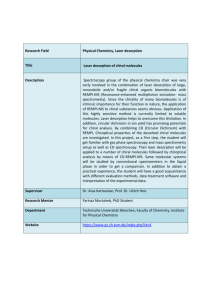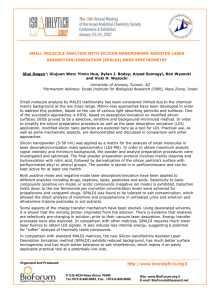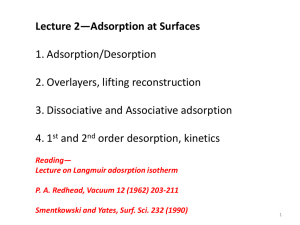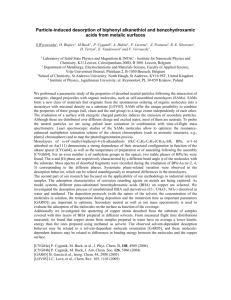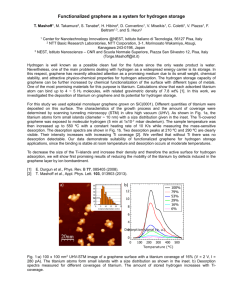Modern Methods in Heterogeneous Catalysis Research:
advertisement
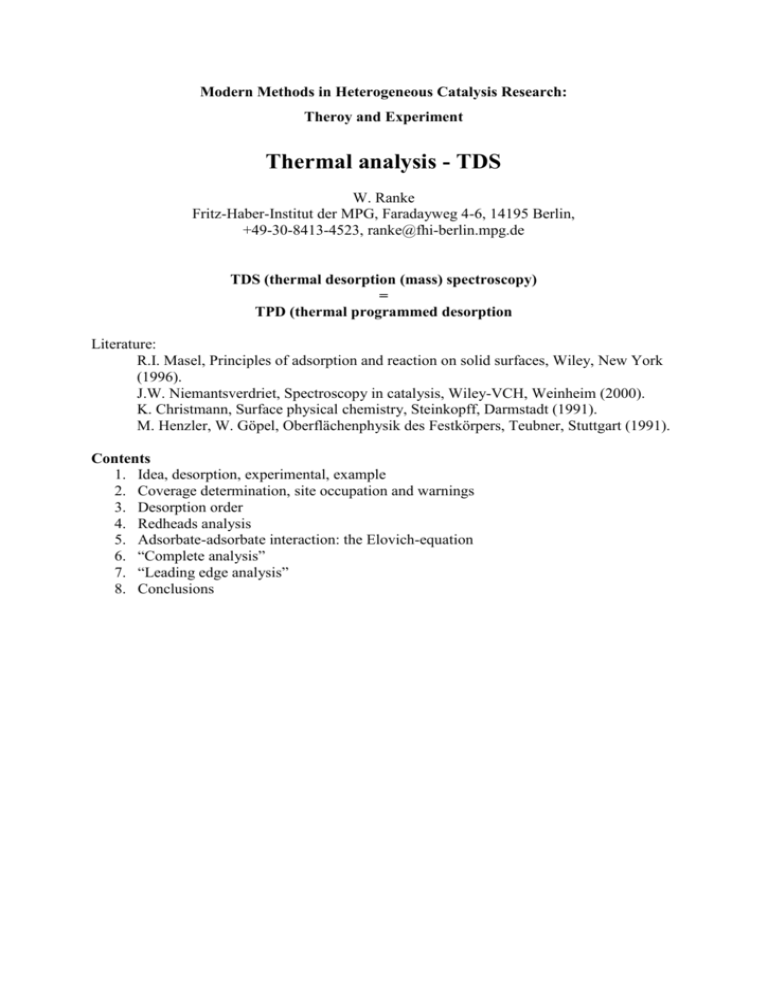
Modern Methods in Heterogeneous Catalysis Research: Theroy and Experiment Thermal analysis - TDS W. Ranke Fritz-Haber-Institut der MPG, Faradayweg 4-6, 14195 Berlin, +49-30-8413-4523, ranke@fhi-berlin.mpg.de TDS (thermal desorption (mass) spectroscopy) = TPD (thermal programmed desorption Literature: R.I. Masel, Principles of adsorption and reaction on solid surfaces, Wiley, New York (1996). J.W. Niemantsverdriet, Spectroscopy in catalysis, Wiley-VCH, Weinheim (2000). K. Christmann, Surface physical chemistry, Steinkopff, Darmstadt (1991). M. Henzler, W. Göpel, Oberflächenphysik des Festkörpers, Teubner, Stuttgart (1991). Contents 1. Idea, desorption, experimental, example 2. Coverage determination, site occupation and warnings 3. Desorption order 4. Redheads analysis 5. Adsorbate-adsorbate interaction: the Elovich-equation 6. “Complete analysis” 7. “Leading edge analysis” 8. Conclusions 1. Idea, desorption, experimental, example Idea: Adsorbed particles with different Ed (energetics) and n, (kinetics) will desorb at different T. Adsorb gas at low T, run a T-ramp, look what desorbs at which T. Desorption from “simple” and “complex” samples (a) desorption from single crystal surface; site inhomogeneity from crystal structure; no pore diffusion limitation; (b) desorption from powder sample; additional inhomogeneity from roughness: sites with different coordination to the substrate; desorption includes pore diffusion; Potential curves for desorption of an undissociated particle: physisorption, chemisorption and sum curve. Potential curves for activated recombinative desorption of an dissociated particle: The activation energy Ed > Had The experiment TDS setup, schematic. The shield should prevent particles from the sample holder to reach the QMS; the pumping speed must be sufficient to suppress readsorption; measurement of the real surface T is not trivial; heat conductivity problems may arise for non-metallic samples. Example: H2O desorption from FeO(111) and Fe3O4(111) Exposures are often given in Langmuir units. 1 L = 10-6 Torr s or 1.33x10-6 mbar s. If the sticking coefficient is 1, it corresponds roughly to 1 ML. The exact value of the exposure is: pt , (cm-2) p in mbar, t in sec, M in g/mol, T in K. 2.63 1022 MT TD-traces for desorption of H2O from (a) FeO(111) and (b) Fe3O4(111). While a small initial peak shift on FeO suggests sequential desorption of physisorbed water and condensed water, a more tighly bound chemisorbed -species saturates first on Fe3O4. Exposure at 100 K, parameter: exposure in Langmuir units. (Y. Joseph et al. Chem. Phys. Lett. 314 (1999) 195) Structure and models for the most tightly bound species: Left: physisorbed -water on almost inert O-terminated FeO(111); Right: -water/Fe3O4(111), bound dissociatively with OH to acidic surface Fe sites, H to basic O-sites. Besides TDS, mainly LEED, STM, UPS, XPS were used to derive these models. (Y. Joseph et al. J. Phys. Chem. 104 (2000) 3224) 2. Coverage determination, site occupation and warnings Features (peaks, shoulders) in TDS traces give a suggestive impression of the number of inequivalent adsorption sites which are occupied sequentially. The total area under a TDS trace is proportional to the initial coverage (if everything really desorbs). The area under individual peaks (if separable) gives the occupation of the corresponding sites. This is an important method for determination of (relative) coverages. Absolute coverages are usually deduced from saturation coverages which are ascribed to certain adsorbate configurations. Warnings: TDS shows you only what is going off the surface. It does not show you what is left. Often, adsorbates decompose irreversibly and eventually form carbonaceous deposits. The sample is exposed at a low temperature where the desorption rate is negligibly small. Often adsorbate mobility is insufficient to fill sequential adsorbate states really sequentially. 3. Desorption order Coverage, rate constant and desorption rate. Shape of desorption traces for different 0=0.67, n=1, =1013s-1, H=10 K/s, Ed=100 desorption orders. (D. Pöss, Diss., TU Berlin (1980). kJ/mol. (Masel fig. 7.11) The desorption rate is given by: σ dΘ rd A r νn σ An Θrn exp ( Ed /kT) . dt Ed: activation energies for adsorption and desorption; A: density of adsorption sites cm-2; r = /sat: relative coverage (0<r<1); n: the frequency factor for desorption order n; n: order of desorption reaction. For practical reasons, I divide the total coverage into = r A. Left: 2D gas with very fast exchange and equilibration with islands (2D vapor pressure in equilibrium with 2D fluid): Desorption rate does not depend on , as long as islands are left; desorption order n=0. The same desorption order is observed for sublimation of thick condensed layers. Right: The desorption rate is proportional to the circumference of the islands and thus proportional to 1/2; desorption order n=1/2. Left: Molecular desorption, mobile or immobile adsorbate; desorption rate proportional to ; desorption order n=1. Right: Associative desorption, at least one of both species must be mobile; desorption rate proportional to 2; desorption order n=2. TDS 1st and 2nd order, for 0=0.2, 0.4…1.0., n=1, =1013s-1, H=10 K/s, Ed=100 kJ/mol. (Masel fig. 7.12) 4. Redhead’s analysis (P.A. Redhead, Vacuum 12 (1963) 203) The desorption rate is: σ dΘ rd A r νn σ An exp ( Ed /kT)Θrn . dt Linear temperature ramp: T = T0 + H t. Combining this yields: rd d r n n r exp( Ed / RT ) , H A dT H T nn1 E Ed ln n P P ln d . RTP H RTP Approximation (Redhead): T Ed RTP ln 1 P 3.46 . H This is only valuable if 1 is reasonably well known. This is often simplified further assuming 1=1013 s-1 to Ed 0.25 TP Ed in kJ/mol, TP in K. This yields an estimation of Ed to 20% . This seems acceptable but is not. For a given (measured) desorption rate at 300 K, an inaccuracy of only ~2.5 kJ/mol results in an inaccuracy of the frequency factor by a factor of 10! Problem: Often the importance of is underestimated. For every practical problem, one needs both and Ed. A number of evaluation methods for Ed and n are based on variation of heating rate H and dependence of TP, the position of the desorption peak maximum. Variation of the heating rate 0=0.67, n=1,2, n/H=1011…1015, Ed=100 kJ/mol. (Masel fig. 7.13) Variation of Ed and 0 0=0.2…1.0, n=1,2, n/H=1012, Ed in kcal/mol. (Masel fig. 7.14) Problem: 5. This applies for one (equilibrated) adsorption state with -independent Ed and . In general, this is not fulfilled. Adsorbate-adsorbate interaction: the Elovich-equation Problem: Ed = Ed(); n = n(). Elovich-equation: Assumption: Ed varies linearly with r. rd νn σ An Θrn exp (Ed0 α E Θr )/kT . TD spectra calculated by numerically integrating the Elovich equation. 0=0.2…1.0, Ed0=100kJ/mol, E=17 kJ/mol, n/K=1012. (Masel fig. 7.22). 6. “Complete analysis” The method uses the rate equation for desorption and allows for a coverage dependence of both n and Ed: rd νn(Θr ) σ An exp Ed (Θr )/kT Θrn . Although Ed, n and n can be derived, this method is not often applied, probably because it needs an engagement into the understanding of the desorption process and is comparatively complicated. It goes back to D.A. King et al. (D.E. King, T.E. Madey, J.T. Yates, Jr., J. Chem. Phys. 55 (1971) 3236). “Complete analysis” of TD data of Ag from Ru(0001): 1. The spectra of (a) are integrated from the right (b) yielding also the initial coverage 0. 2. Depending on 0, a certain coverage (as example, r=0.15 is chosen) is reached at different temperatures. 3. The original TD traces at r=0.15 give the corresponding values of the desorption rate rd. 4. For this coverage, one obtains pairs of (rd, T). An Arrhenius-plot ln(rd) vs. 1/T is made (c). 5. The slope yields Ed and the intercept equals ln(n) + n ln(r). (J.W. Niemantsverdriet et al., J. Vac. Sci. Technol. A5 (1987) 857). 7. “Leading edge” method (E. Habenschaden, J. Küppers, Surf. Sci. 138 (1984) L147) Idea: In the region of the first data points at the leading edge of a TD trace (low-T onset of the curves), the total coverage r is almost unchanged and can be considered as constant: r 0 . The rate equation becomes rd νn(Θ0 ) σ An Θ0n exp Ed (Θ0 )/kT . For each (known) 0, an Arrhenius plot ln(rd) vs. 1/T of this short interval should yield a straight line. From the slope, Ed(0) and from the intercept, n ln(0) + ln(n) can be deduced. If it is known that n=1, one may plot ln(rd/r) vs. 1/T allowing use of a larger part of the desorption curve. Low coverage TD-traces of H2O on Fe3O4(111). The first data points at the leading edge can be approximated by a simple Polanyi-Wigner (exponential) behaviour. Problem: 8. Need for extremely good data for the small used interval. Conclusions “Simple” surfaces: Suggestive: Number of consecutively adsorbing species Qualitatively: Distinction of chemisorbed, physisorbed, condensed species Quantitative: Evaluation of coverages possible; evaluation of Ed, n and n difficult, many parameters. “Complex” surfaces: So far only qualitative evaluation.
